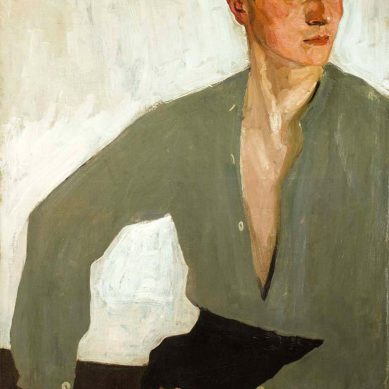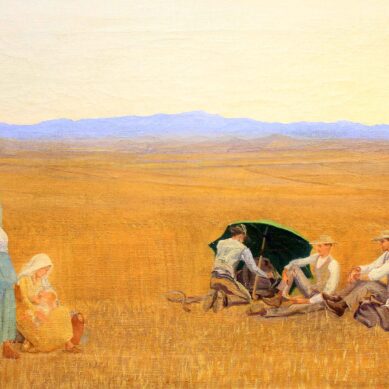You searched
Painter
Renato Tomassi
Are you interested in the sales or the purchase of his artworks?
We buy works of this artist
and of other painters and sculptors from the 16th century to the first half of the 20th century
The Berardi gallery offers a free and without obligation service for evaluation of ancient and modern art . To find your way in the art market, very complex and full of nuances, it is better to rely on a professional consultant who can answer fast and concretely to your needs. The clarity of the answers will resolve effectively the need to estimate or sell an asset.
Contact us immediately without commitment
Answers also in 24 hours:
Renato Tomassi
Renato Tomassi
Renato Tomassi was born in Subiaco in 1884. Having demonstrated his talent for drawing from a very young age, he was encouraged to cultivate his aptitude by the Hungarian painter Robert Wellmann, who had his own studio in Subiaco.
The pro-German environment in Rome
Initiated into a naturalistic style of painting, based on the careful and optical rendering of details, the young Tomassi was sent to Rome to complete his training in Sigmund Lipinsky’s studio-academy in Via Margutta, entering with great ease into the Roman circle of pro-German painters. In addition to Lipinsky, it was Otto Greiner, the German painter who settled in Rome at the end of the 19th century, who particularly influenced the meticulous realism of the early Tomassi.
The formal strength of Greiner’s graphic outline can be seen in the works he exhibited at the Amatori e Cultori Exhibition in Rome in 1907. Unlike Greiner, however, Tomassi never turned to antiquarian, mythological or heroic subjects, preferring scenes of everyday intimacy, delicate portraits, incisive and energetic narratives of human introspection with a Symbolist flavour, as can be seen in the Portrait of a Prelate of 1906.
The 1910s: Rome, Subiaco and the front line
At the beginning of the 1910s, he went on a study trip to Berlin and Munich, which was fundamental to the Secessionist undertone evident in his later works. On his return to Italy, he divided his time between Rome, Subiaco and the Arcinazzo highlands. He produced works such as Portrait of the Mother in the National Gallery in Rome, which once again demonstrates the extreme sensitivity expressed in this genre so congenial to him. The same can be seen in the work Maria Ciaffi, which shows undeniable Secessionist influences, especially in the choice of a linear graphic style that is expressed in the outline of the woman, well separated from the surrounding atmosphere. Nevertheless, although he showed clear Nordic ancestry, he did not take part in the Roman Secession, continuing to exhibit exclusively with the Amatori e Cultori of the first half of the 1910s, even during the war, when he left for the front and remained there until 1918. This experience, however, allowed him to continue painting, documenting above all the landscapes of the war, the Trentino front, the mountains, the camps, the military life in the trenches, in works such as Monte Corvo or Il soldato dagli occhi verdi of 1917.
From these wartime works, Tomassi initiated a new language: for a certain period, the dry and decisive outline no longer prevailed, but a vibrant and luminous chromatism, which he handled with fluency and vivacity, demonstrating stylistic points of contact with Schiele, but excluding his dramatic torment.
By joining the Deutscher Künstlerverein in Rome, Tomassi confirmed the pro-German vocation of his painting, which was also validated by the long series of commissions he received from German collectors and families in Rome, including the Bretschneider family.
The Twenties and Thirties: a poetic ‘suspended’ between contour, light and colour
In 1921, he married Nadia Bretschneider, a very important figure for the painter, a muse he would portray very often in the years that followed, together with his children Enza and Andrea. Renato Tomassi interprets the return to order not by celebrating unbridled classicism, but through a balance that is expressed both in the outline and in the soft, serene colour, and that still reveals tangents with Nordic and Secessionist painting, in particular that of Hodler.
At the Florentine Spring Exhibition of 1922 he exhibited Adam and Eve, Portrait of a Young Woman, a Nude Study, My Mother, a Head Study and Black Cat. The sharpness of the outlines, the suggestive and dreamy quality of his painting were at their most evident in these years, with the production of works such as Susanna e vecchioni (Susan and Old Men), exhibited together with many other works in his one-man show at the Teatro Nazionale in 1923, the year in which he also exhibited at the second Roman Biennial. He also presented some works executed on Capri, which burst forth with a vivid chromatism made up of small touches of light: Window in Capri, The terrace, and Morning in Capri.
The spontaneity of everyday life is combined with intense and introspective portraits, often dedicated to family affections, such as My Wife of 1925 and My Daughter of 1926, works that inevitably contain that “metaphysical” silence of indecipherable faces of timeless beauty reminiscent of Pollaiolo’s Quattrocento or Piero Della Francesca, as can also be seen in Alla fonte of 1932.
At the end of the 1930s, after continuing to take part in the exhibitions of the Amatori e Cultori and the Sindacali exhibitions, he left for Germany. The German years and the post-war period led him to a complete stylistic change in an expressionist direction. Canvases such as Nordic Landscape of 1952 and Nude on the Beach bear witness to this.
Elena Lago








